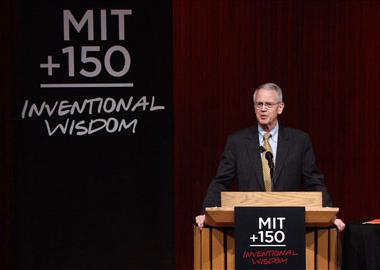 Personal reminiscence and professional observations share the stage in the second panel of this symposium on computation.
Personal reminiscence and professional observations share the stage in the second panel of this symposium on computation.As a boy, former MIT President Charles (Chuck) Vest daydreamed about going on a rocket ship to the moon, having a tiny TV, and obtaining a Dick Tracy wristwatch. While he never made it to the moon (though he knows those who have), he has fulfilled other wishes, thanks to “amazing developments in computing:” mobile devices he can carry in his pocket that combine watch, TV and many more functions.
Vest was on hand for the dawn of the digital revolution, and recalls learning to program in Fortran in college in 1961, and describes a computer with 8 bits of memory held in a mercury vapor tube. He developed a recurring nightmare after many nights carrying boxes full of punched cards to the University of Michigan computer center, and worrying about “one little bug ruining the whole program.” He held onto the cards until he moved to Cambridge in 1990.
While working as a young faculty member in the field of optical holography, Vest said his team became the “nth group to develop the idea
of computer tomography—where n is a big number.” Even after he fell into the “dark chasm of academic administration,” Vest plunged forward with computing, as an early email adopter. He is especially proud of helping to bring Tim Berners-Lee to the MIT computer lab, and supporting the launch of the World Wide Web.
While Vest believes computation in its next phase will be used to “model and simulate at extreme scales, to understand and perfect systems of unprecedented complexity,” and help meet the critical challenges of our times, he worries that problems of cybersecurity might “mess up the grand global adventure” of the World Wide Web, and that the systems computer science and engineering create might “become so complicated we can’t think about all the possible end states,” conceivably resulting in disaster. But as an avowed optimist, Vest trusts that the collaborative spaces engendered by computing will lead to new forms of global problem solving and learning.
Computation methods have opened up new ways of looking at the earth and its systems, says Maria Zuber. She unveils a set of remarkable visualizations, all courtesy greater computing muscle, that help explain events from the past, illustrate complex interactions of the present, and predict the future. A simulation has bolstered the theory that a giant impact striking earth at a “strafing angle” sent enough material in orbit to form the moon several billion years ago. Another model demonstrates why a period of heavy bombardment of the moon occurred, and how comparable impacts on earth caused vulcanism, degassing, and the formation of our planet’s atmosphere, oceans and life itself.
Zuber shows animations of the dynamics inside the earth; the evolution of enormous landscapes; the circulation of ocean currents, including the underappreciated role of eddies; and the distribution of phytoplankton. MIT computer programs verify greenhouse gas emissions regulated under the Kyoto Protocol, tracing the flow of these gases around the planet, and the Institute is behind a lot of the improvements in weather prediction models.
Zuber sees several areas ripe for computational progress: modeling subsurface transport, which will prove critical in the effort to sequester CO2 underground; atmosphere-ocean exchange, which describes how sea spray captures CO2 and deposits it on the ocean floor as organic carbon; and finally a super-detailed model of the entire earth system, including solids and fluids....Read the full article/Watch Video
While Vest believes computation in its next phase will be used to “model and simulate at extreme scales, to understand and perfect systems of unprecedented complexity,” and help meet the critical challenges of our times, he worries that problems of cybersecurity might “mess up the grand global adventure” of the World Wide Web, and that the systems computer science and engineering create might “become so complicated we can’t think about all the possible end states,” conceivably resulting in disaster. But as an avowed optimist, Vest trusts that the collaborative spaces engendered by computing will lead to new forms of global problem solving and learning.
Computation methods have opened up new ways of looking at the earth and its systems, says Maria Zuber. She unveils a set of remarkable visualizations, all courtesy greater computing muscle, that help explain events from the past, illustrate complex interactions of the present, and predict the future. A simulation has bolstered the theory that a giant impact striking earth at a “strafing angle” sent enough material in orbit to form the moon several billion years ago. Another model demonstrates why a period of heavy bombardment of the moon occurred, and how comparable impacts on earth caused vulcanism, degassing, and the formation of our planet’s atmosphere, oceans and life itself.
Zuber shows animations of the dynamics inside the earth; the evolution of enormous landscapes; the circulation of ocean currents, including the underappreciated role of eddies; and the distribution of phytoplankton. MIT computer programs verify greenhouse gas emissions regulated under the Kyoto Protocol, tracing the flow of these gases around the planet, and the Institute is behind a lot of the improvements in weather prediction models.
Zuber sees several areas ripe for computational progress: modeling subsurface transport, which will prove critical in the effort to sequester CO2 underground; atmosphere-ocean exchange, which describes how sea spray captures CO2 and deposits it on the ocean floor as organic carbon; and finally a super-detailed model of the entire earth system, including solids and fluids....Read the full article/Watch Video
For more techical information visit our sister website www.engineeringmaintenance.info or for equipment procurement please visit www.engineeringtrader.com

